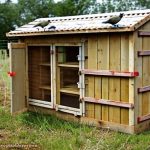Maintaining appropriate water levels in an incubator is critical for successful egg hatching. Proper humidity levels, which are directly influenced by water content, are essential for embryo development. Insufficient humidity can cause eggs to dehydrate, resulting in hatching failure.
Conversely, excessive humidity may promote bacterial growth and compromise air quality, potentially harming embryo development. Water in the incubator also plays a crucial role in temperature regulation. It helps stabilize the internal temperature and minimize fluctuations, which is vital for healthy embryo growth.
Consistent temperature is necessary for optimal development and successful hatching. By ensuring correct water levels, incubators can provide the ideal environment for egg development and hatching. This balance of humidity and temperature stability is fundamental to the incubation process and ultimately determines the success rate of egg hatching.
Table of Contents
- 1 Factors to Consider When Determining Water Levels
- 2 Guidelines for Water Levels Based on Incubator Type
- 3 Adjusting Water Levels for Different Stages of Incubation
- 4 Monitoring and Maintaining Water Levels
- 5 Potential Risks of Incorrect Water Levels
- 6 Conclusion and Recommendations for Optimal Water Levels
- 7 FAQs
- 7.1 What is the importance of water in an incubator for chickens?
- 7.2 How much water should be kept in the incubator for chickens?
- 7.3 What happens if there is too much water in the incubator for chickens?
- 7.4 What happens if there is too little water in the incubator for chickens?
- 7.5 How often should the water in the incubator for chickens be checked and refilled?
Key Takeaways
- Proper water levels in the incubator are crucial for successful egg incubation and hatching.
- Factors to consider when determining water levels include egg size, humidity requirements, and the type of incubator being used.
- Guidelines for water levels vary based on the type of incubator, such as still-air or forced-air models.
- Adjusting water levels for different stages of incubation is important to meet the changing needs of developing embryos.
- Monitoring and maintaining water levels regularly is essential to ensure optimal conditions for egg incubation and hatching.
Factors to Consider When Determining Water Levels
Incubator Type and Capacity
The type of incubator being used is a crucial factor to consider when determining water levels. Different types of incubators have different water reservoir capacities and requirements, so it’s important to follow the specific guidelines for each type of incubator.
Incubator Size and Egg Capacity
The size of the incubator and the number of eggs being incubated will also impact the amount of water needed. Larger incubators with more eggs will require more water to maintain the appropriate humidity levels compared to smaller incubators with fewer eggs.
Environmental Conditions and Incubation Stage
The local climate and environmental conditions also play a significant role in determining water levels in the incubator. In drier climates, more water may be needed to maintain optimal humidity levels, while in more humid climates, less water may be required. Additionally, the stage of incubation is another important factor to consider when determining water levels. The water requirements may vary at different stages of incubation, so it’s essential to adjust the water levels accordingly as the eggs progress through the incubation process.
Guidelines for Water Levels Based on Incubator Type

Different types of incubators have specific guidelines for maintaining proper water levels. Still-air and forced-air models are two common types of incubators, each with its own requirements for water levels. In still-air models, which rely on natural convection for heat distribution, it’s important to maintain a higher water level to ensure proper humidity levels.
The larger surface area of water helps to increase evaporation and maintain consistent humidity levels inside the incubator. On the other hand, forced-air models, which use fans to circulate air and distribute heat more evenly, may require a lower water level due to increased air circulation and evaporation. In general, most incubators come with instructions and guidelines for maintaining proper water levels based on their specific design and capacity.
It’s important to follow these guidelines closely to ensure that the humidity levels inside the incubator remain within the recommended range for successful egg development. Additionally, some advanced models of incubators may come with automatic humidity control features, which can help maintain optimal water levels without constant manual adjustments. These features can be particularly useful for novice hatchers or those with limited experience in managing incubation conditions.
Adjusting Water Levels for Different Stages of Incubation
As the eggs progress through the different stages of incubation, it’s important to adjust water levels accordingly to meet their changing requirements. During the first few days of incubation, higher humidity levels are generally recommended to support proper embryo development. This is particularly important during the initial stages when the embryos are most vulnerable and sensitive to changes in environmental conditions.
As the eggs approach the hatching stage, it’s common practice to reduce the water level to lower humidity levels, which can help prevent excessive moisture buildup inside the eggs and facilitate easier hatching. It’s important to monitor the development of the embryos closely and make adjustments to the water levels as needed throughout the incubation process. Some incubators may come with built-in hygrometers or humidity sensors to help monitor and maintain optimal humidity levels automatically.
However, manual monitoring and adjustments may still be necessary, especially in cases where external factors such as climate and environmental conditions can impact humidity levels inside the incubator. By adjusting water levels based on the specific requirements of each stage of incubation, hatchers can create an ideal environment for healthy embryo development and successful hatching.
Monitoring and Maintaining Water Levels
Regular monitoring and maintenance of water levels are essential for ensuring optimal conditions inside the incubator. It’s important to check the water reservoir regularly and top it up as needed to prevent fluctuations in humidity levels. In some cases, adding a wet sponge or cloth inside the incubator can help increase humidity levels without overfilling the water reservoir.
However, it’s important to avoid overcrowding the incubator with excessive moisture sources, as this can lead to poor air quality and increased risk of bacterial growth. In addition to maintaining proper water levels, it’s also important to keep an eye on other environmental factors such as temperature and ventilation inside the incubator. These factors can also impact humidity levels and overall conditions for embryo development.
Regularly cleaning and sanitizing the water reservoir is also crucial for preventing bacterial contamination and ensuring a healthy environment for embryo development. By staying vigilant and proactive in monitoring and maintaining water levels, hatchers can create an optimal environment for successful egg incubation and hatching.
Potential Risks of Incorrect Water Levels

Risks of Low Humidity
If humidity levels are too low, it can lead to excessive moisture loss from the eggs, resulting in dehydration and failed hatching.
Risks of High Humidity
On the other hand, if humidity levels are too high, it can create a damp environment inside the incubator, increasing the risk of bacterial growth and poor air quality, which can negatively impact embryo development.
Importance of Consistent Water Levels
Fluctuating humidity levels due to inconsistent water levels can also stress the embryos and lead to poor hatch rates. Furthermore, incorrect water levels can also impact temperature regulation inside the incubator. Inadequate water levels can lead to temperature fluctuations, which can be detrimental to embryo development. Consistent and stable temperature is crucial for healthy embryo growth, so maintaining proper water levels is essential for creating a stable environment inside the incubator.
Conclusion and Recommendations for Optimal Water Levels
In conclusion, proper water levels in the incubator are essential for creating an optimal environment for successful egg incubation and hatching. Maintaining appropriate humidity levels is crucial for supporting healthy embryo development, while also playing a significant role in regulating temperature inside the incubator. When determining water levels, factors such as incubator type, size, local climate, and stage of incubation need to be taken into consideration.
Following specific guidelines for each type of incubator and making adjustments based on the changing requirements of each stage of incubation is essential for creating an ideal environment for embryo development. Regular monitoring and maintenance of water levels are necessary to prevent fluctuations in humidity levels and ensure a stable environment inside the incubator. Incorrect water levels can pose several risks to embryo development and overall hatch success, so it’s important to be mindful of potential risks and take proactive measures to maintain proper water levels throughout the incubation process.
By following these recommendations and guidelines for optimal water levels in the incubator, hatchers can increase their chances of successful egg hatching and achieve better overall hatch rates.
If you’re wondering how much water to keep in the incubator for chickens, you may also be interested in learning about how long it takes for chicken eggs to hatch naturally. This article provides valuable information on the incubation process and what to expect when hatching chicken eggs. Understanding the incubation period can help you better care for your chicks and ensure they have the best start in life.
FAQs
What is the importance of water in an incubator for chickens?
Water is essential for the development of chicken embryos in the incubator. It helps to maintain the proper humidity levels, which is crucial for the successful hatching of the eggs.
How much water should be kept in the incubator for chickens?
The amount of water to keep in the incubator for chickens depends on the size and type of the incubator, as well as the local humidity levels. Generally, it is recommended to fill the water reservoirs in the incubator to maintain a humidity level of 45-55% during the first 18 days of incubation, and then increase it to 65-75% during the last 3 days before hatching.
What happens if there is too much water in the incubator for chickens?
Excessive water in the incubator can lead to high humidity levels, which can negatively impact the development of the chicken embryos. It can cause the eggs to lose too much moisture, resulting in shrink-wrapped or sticky chicks that have difficulty hatching.
What happens if there is too little water in the incubator for chickens?
Insufficient water in the incubator can lead to low humidity levels, which can also negatively impact the development of the chicken embryos. It can cause the eggs to lose too little moisture, resulting in chicks that are unable to break through the shell during hatching.
How often should the water in the incubator for chickens be checked and refilled?
The water in the incubator should be checked at least once a day, and refilled as needed to maintain the proper humidity levels. It is important to monitor the humidity levels regularly to ensure the successful hatching of the chicken eggs.
Meet Walter, the feathered-friend fanatic of Florida! Nestled in the sunshine state, Walter struts through life with his feathered companions, clucking his way to happiness. With a coop that’s fancier than a five-star hotel, he’s the Don Juan of the chicken world. When he’s not teaching his hens to do the cha-cha, you’ll find him in a heated debate with his prized rooster, Sir Clucks-a-Lot. Walter’s poultry passion is no yolk; he’s the sunny-side-up guy you never knew you needed in your flock of friends!







